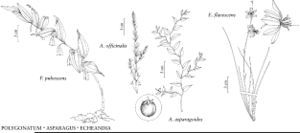Difference between revisions of "Asparagus asparagoides"
Rep. Bot. Exch. Club Soc. Brit. Isles 3: 414. 1914.
Common names: Smilax asparagus
Basionym: Medeola asparagoides Linnaeus
FNA>Volume Importer |
FNA>Volume Importer |
||
| Line 27: | Line 27: | ||
|elevation=0–100 m | |elevation=0–100 m | ||
|distribution=Calif.;s Africa. | |distribution=Calif.;s Africa. | ||
| − | |discussion=<p>Asparagus asparagoides is cultivated as an ornamental and has naturalized locally in southern Europe.</p> | + | |discussion=<p><i>Asparagus asparagoides</i> is cultivated as an ornamental and has naturalized locally in southern Europe.</p> |
|tables= | |tables= | ||
|references= | |references= | ||
| Line 52: | Line 52: | ||
|publication year=1914 | |publication year=1914 | ||
|special status= | |special status= | ||
| − | |source xml=https://jpend@bitbucket.org/aafc-mbb/fna-data-curation.git/src/ | + | |source xml=https://jpend@bitbucket.org/aafc-mbb/fna-data-curation.git/src/8f726806613d60c220dc4493de13607dd3150896/coarse_grained_fna_xml/V26/V26_369.xml |
|genus=Asparagus | |genus=Asparagus | ||
|species=Asparagus asparagoides | |species=Asparagus asparagoides | ||
Revision as of 17:44, 18 September 2019
Vines, erect to deflexed, branching, climbing to 1.5 m; roots tuberous. Stems slender, to 3 m, wiry, smooth to slightly ridged; cladophylls solitary at each node, broadly lanceolate to ovate, 15–35 × 5–15(–20) mm, leathery, with 20–24 parallel veins. Leaves membranous, 1–2 mm; blade broadly lanceolate. Inflorescences in axillary umbels, 1–3(–4)-flowered. Flowers bisexual; perianth campanulate; tepals white, with green median stripe abaxially, 5–7 × 1–1.5 mm; pedicel 5–8 mm, with hard, raised joint 1–3 mm above base. Berries red, 6–8 mm. Seeds 1–4(–6). 2n = 20.
Phenology: Flowering spring–summer.
Habitat: Waste places, open forests, roadsides
Elevation: 0–100 m
Distribution

Calif., s Africa.
Discussion
Asparagus asparagoides is cultivated as an ornamental and has naturalized locally in southern Europe.
Selected References
None.
Lower Taxa
None.
